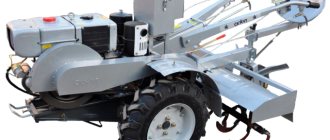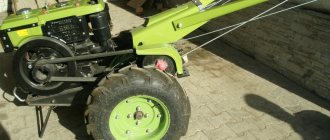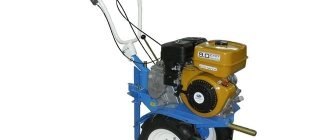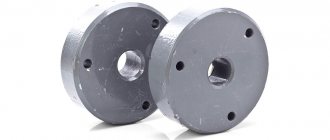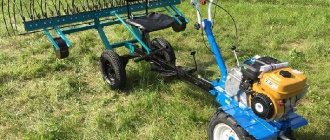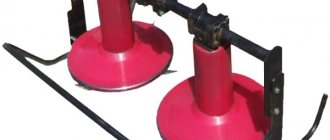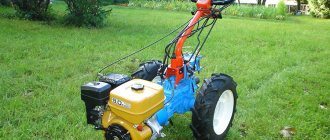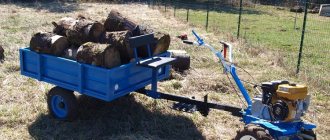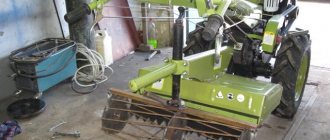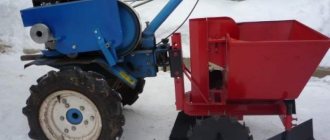Wheels for walk-behind tractor: overview of types, how to make it yourself
In most cases, before buying a walk-behind tractor, people pay special attention to the practical characteristics of the device, without being interested in the quality and features of the wheels.
This approach can hardly be called competent, because the quality and duration of operation of the equipment itself depend on these details. Since this unit is a multifunctional device, different wheels for the walk-behind tractor are offered:
- pneumatic;
- traction wheels;
- solid rubber versions;
- metal wheels with lugs.
In order to clearly understand the specifics of each type, you should consider their features in more detail.
On 4 wheels
The 4 wheels can be installed in different ways on the device. The first option is to transform the equipment into a mini-tractor and equip it with a seat. The second option is more common when making homemade equipment. In this case, and the use of unsuitable machine or motorcycle parts, two identical pairs are paired with each other.
Standard conversion of equipment into a mini-tractor is a common procedure if the unit has sufficient power. For this process, a free axis is created, which is installed on an elongated body. Paired equipment is placed on this axis.
When using the paired version, two sibling pairs are broken up and paired with the second wheel. It is also possible to install weighting agents between adjacent disks, but in homemade work, most often the disks are paired with a small gap using a small rectangular window, which then serves as a weighting agent.
Important! Paired options can be either solid rubber or pneumatic, but one pair must have an aggressive tread.
When fully created, each part will be a double element, which is created from equal parts. It turns out that the elements must be the same in shape and size.
Among the advantages of this design:
- higher level of productivity;
- quick removal of external parts;
- ease of creation;
- high level of contact with the surface.
The main advantages are increased maneuverability and increased speed.
A walk-behind tractor with 4 wheels is considered the most practical for creating at home.
Pneumatic
These options are perfect for frequent plowing and digging up root crops.
An important point: the width of the wheels should in no case be less than 20 cm, and the diameter – 40 cm. The aggressive tread pattern will be a huge plus. Pneumatic components contribute to the incredible stability of the unit, but if damaged they must be replaced. They are often sold as wheels for Neva walk-behind tractors.
Pneumatic wheels for walk-behind tractor
Pneumatic wheels are used in various models of equipment. This is possible due to the presence of high permeability on any type of soil. Among the features of pneumatic tires are:
- Christmas tree protector;
- sufficient width;
- standard dimensions are 20 cm in width and 40 cm in diameter;
- Large size facilitates use over large areas.
Important! Pneumatic options may be different, but if available, it is better to use those with a more aggressive tread type.
When choosing sizes, you also need to pay attention to the technical characteristics of the walk-behind tractor itself.
Each type of model has its own characteristics that need to be taken into account. This is interesting: wheels on the Neva walk-behind tractor.
Independent creation of equipment for machinery depends on numerous factors, including the availability of parts and the required tools. If necessary, you can use old wheels from cars or motorcycles. The main condition is suitable dimensions for the walk-behind tractor class. The entire process is carried out in accordance with a sequential order of actions, that is, first the preparation of materials occurs, then drawing up a drawing, if necessary, and taking measurements. Only after this you need to start working independently.
Tags: manufacturing, rims, weight, factory, need, make, cultivator, clutch, task, automobile, ground, tires, chassis, holes, other, steel, heavy, most, pipes, make, quality, install, devices, configuration, follows, sections, bolts, pancakes, trailer, allows, excellent, read, drawing, possibility, teeth, complex, metal, landing, operation, take, maximum, rubber, wheeled, weights, processing, instructions, provide, very, pick up, terrain
Metal with lugs
Such wheels have a certain weight, so they have additional power.
Steel teeth “push” the unit forward and do not allow it to load even in the most clay soil. Particular attention must be paid to the support front wheel, which bears a considerable load. It helps to optimize land work and increase the endurance of the walk-behind tractor itself.
Trailer wheels have a similar classification and are selected according to the same principles. Do not forget that in the process of transporting heavy loads, low pressure is applied to the wheels of the walk-behind tractor itself, and high pressure is applied to the wheels of the cart (trailer). Therefore, in this case you need to choose the most durable options.
How to make wheels for a walk-behind tractor with your own hands?
You need to understand that it is impossible to make wheels from scratch with your own hands. It is necessary to find the basis and only then can we begin to form improved and useful devices.
Wheels from a motorcycle or car should be used as this base. You can only create a version with a lug on your own, because if wheel weights are not used so often, there is no point in purchasing new expensive products. On our website you can find a specialized article where all the features of creating lugs with your own hands are discussed in detail.
How to make wheels for a walk-behind tractor
There are people who don't want to spend money on buying new wheels. Instead, they make them themselves. However, before you do this, you need to figure out how you can make walk-behind wheels yourself.
Instructions
When creating homemade walk-behind wheels, car rims are most often used.
Most often, homemade structures are made from passenger car rims. If done correctly, these wheels can last more than ten years.
Before creating discs for a walk-behind tractor, you need to prepare the necessary tools and materials. To work you will need the following:
- steel sheet about 8 mm thick;
- car wheels;
- tires;
- bolts;
- washers;
- Bulgarian;
- drill.
Having prepared everything you need, you can start working. The step-by-step instructions are as follows:
- Making templates from cardboard or plywood sheets.
- Manufacturing a flange according to a previously made template.
- Creating a bolt pattern.
- Drilling holes that will be used in the future for installing weights.
- Welding a workpiece to a car rim.
- Installation of weights.
After completing the above steps, you can begin installing the tires.
Wheels are the basis of any walk-behind tractor. Therefore, every person who is going to acquire such equipment should familiarize themselves in advance with the types of walk-behind tractor wheels and their key features.
How to make twin wheels yourself?
A simple and even a little crude, but effective method has gained particular interest among farmers:
- First you need to find suitable wheels and tires;
- Then it is advisable to cut small protectors on them;
- The next step is that people buy a strip of steel 5x50mm, weld squares with a side of 250mm and insert them into the rim;
- After welding, the second wheel rim is installed and objects that look like vases are obtained;
- Upon completion, tires are put on the resulting rims and the paired wheels are ready for use.
It is not difficult to obtain such useful devices; the main thing is to decide which options are needed and select all the necessary “ingredients”.
We make wheels for a walk-behind tractor with our own hands
A walk-behind tractor is a technique that is familiar to most farmers. In fact, this is a mobile tractor that is used for plowing soil, planting plants or transporting goods. It is convenient in small summer cottages, where it is already difficult to do everything by hand, but a large tractor is not needed. If you are reading this article, then you either already have a walk-behind tractor or are planning to purchase one.
One of the most common questions from owners of this equipment is how to make wheels for a walk-behind tractor with your own hands? The thing is that in the standard configuration they wear out very quickly, and are also not suitable for all types of soils and terrain. Buying new ones is quite expensive, so you can resort to your own skills. In this article we will look at exactly how to do this.
Types of wheels
First you need to figure out what types of wheels for walk-behind tractors exist. Since the equipment is used in many farming processes, the equipment varies. This also applies to pneumatic wheels, because good results and ease of use also depend on the right components. It is important to note that ordinary car wheels from Oka, Niva or Moskvich cannot be installed on the walk-behind tractor. All of the options below are larger and heavier. It would be more correct to compare them with ATV kits, although they do not always have the appropriate size.
- Pneumatic. This option can be used for arable work and for removing roots from the soil. These are large wheels in appearance, with a diameter of 40 cm and a width of 20 cm. The tread pattern must be rough for the walk-behind tractor to work well on the soil. Often this option comes as standard and is famous for its wear resistance. However, if they become unusable, you should immediately look for a replacement.
Winter wheels on a walk-behind tractor
If the equipment will be used in the cold season, for driving in the snow, you will have to install winter tires on the wheels of the cultivator. It has a number of characteristic features, among which are the following:
- Special protector. Winter tires have deeper grooves, which allow you to drive on snowy roads without problems. Also, some wheels are equipped with additional lugs to improve traction.
- Changes in rubber properties depending on weather conditions. Winter tires contain more rubber. Thanks to this, even at low temperatures, they remain relatively elastic and soft.
- The presence of additional spikes. On the surface of high-quality winter tires you can see a large number of studs.
Winter wheels are best used only in temperatures below zero.
